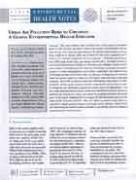Riesgos de la contaminación del aire en la ciudad en los niños

Sinopsis
Millones de niños que viven en las ciudades más grandes del mundo, particularmente en los países en desarrollo, están expuestos a una contaminación del aire que amenaza la vida de dos a ocho veces por encima de las directrices máximas de la Organización Mundial de la Salud (OMS).
Resultados clave
Given the projected growth of cities and the relatively young average age of their populations, regional and international efforts to control air pollution are of increasing importance. Pollution does not discriminate between nations; efforts need to concentrate on standardizing monitoring and data collection methods and on information sharing. Actions to promote energy efficiency, especially in transport and energy sectors, will have collateral benefits to protecting the health of millions of children.
Resumen ejecutivo
Millions of children living in the world’s largest cities, particularly in developing countries, are exposed to life-threatening air pollution two to eight times above the maximum World Health Organization (WHO) guidelines. Indeed, more than 80 percent of all deaths in developing countries attributable to air pollution-induced lung infections are among children under 5.
These are some of the findings of Urban air pollution risks to children: A global environmental health indicator.The authors developed an Environmental Health Indicator (EHI) to identify and rank cities with the most threatened children which reveals that some of the highest risks to children occur in cities in Mexico, India, China, Brazil, and Iran.
The authors also emphasize that interventions are needed for the developed world, where WHO has found that fine particulate pollution is responsible for 7 to 10 percent of respiratory infections in European children (21 percent in the most polluted cities). New York, Paris, Tokyo and Los Angeles have among the highest levels of traffic-based pollution in the world. Reducing fossil fuel use will have significant impacts on public health.